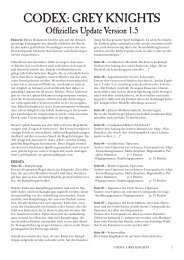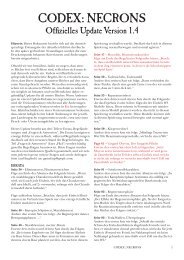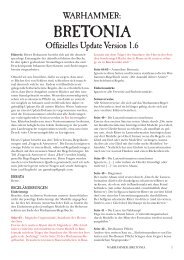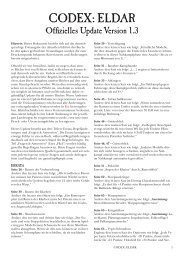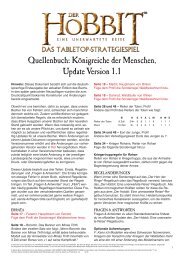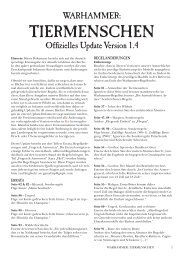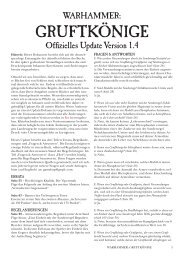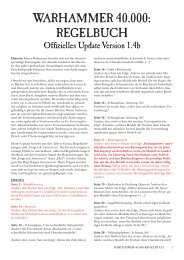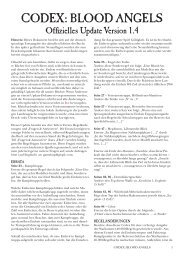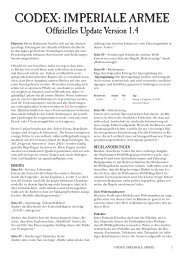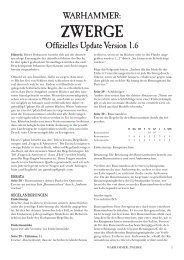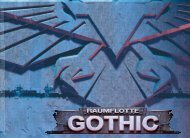Necromunda rulebook - Games Workshop
Necromunda rulebook - Games Workshop
Necromunda rulebook - Games Workshop
You also want an ePaper? Increase the reach of your titles
YUMPU automatically turns print PDFs into web optimized ePapers that Google loves.
NECROMUNDA<br />
THE FAST DRAW<br />
Once a fighter goes for his gun everyone draws their<br />
weapons and the shooting starts. For a second or two<br />
all hell breaks loose as guns are drawn and shots<br />
fired. This is called the fast draw. During the fast draw<br />
neither side is allowed to move but both sides are<br />
allowed to shoot.<br />
In the fast draw both sides can shoot but the order in<br />
which individual models shoot is determined<br />
separately. To decide the firing order roll a D6 for<br />
each model and add the fighter’s Initiative<br />
characteristic to the score. Then add +1 if the fighter<br />
has a pistol, and subtract -1 if armed with a heavy<br />
weapon. The result is the fighter’s Fast Draw score.<br />
Work out the Fast Draw score for each fighter – the<br />
fighter with the highest score shoots first. Work out<br />
the shot exactly as you would normally. Once the first<br />
model has shot the next highest score shoots, then<br />
the next, and so on. In the case of a tie, a pistol<br />
weapon will shoot before a basic, special or heavy<br />
weapon, but otherwise shots are assumed to be<br />
simultaneous. This means that it is possible for two<br />
gang fighters to shoot each other at the same time!<br />
Fighters who are hit before they get a chance to fire<br />
lose their shot.<br />
Once all fighters have shot the normal sequence of<br />
play resumes. Each player rolls a D6, and the player<br />
that scores the highest gets the first turn.<br />
120<br />
ENDING THE GAME<br />
The game ends if one side fails a Bottle roll, or<br />
volunteers to bottle out. The other side automatically<br />
wins the shoot-out and the other side loses.<br />
If you win the shoot-out and the defeated gang drew<br />
first, roll a D6. On a roll of 1-5 your opponent may<br />
only draw half his normal income following the fight<br />
– his gang’s contacts are reluctant to deal with the<br />
troublemaker. On a roll of 6 the defeated gang draws<br />
half its normal income and must surrender one<br />
randomly determined territory to the winner –<br />
associates of the gang no longer have faith in its<br />
leadership.<br />
EXPERIENCE<br />
Fighters who take part in the shoot-out earn<br />
Experience points as noted below.<br />
+? Held Nerve. Each surviving gang fighter of the<br />
side that held their nerve the longest scores a number<br />
of victory points equal to the difference between the<br />
two sides’ scores (see The Build Up rules above).<br />
+D6 Survives. If the fighter survives the battle then<br />
D6 points are earned. Even fighters who are<br />
wounded and taken out of action receive experience<br />
for taking part.<br />
+5 Per Wounding Hit. A fighter earns 5 points for<br />
each wounding hit he inflicts during the battle. Make<br />
a note on the gang roster every time the fighter scores<br />
a hit and wounds his target. Although it is possible to<br />
inflict several wounds from one shot using some<br />
weapons, only 5 points are earned when this<br />
happens not 5 points per wound.<br />
+D6 Winning Side. Each surviving fighter on the<br />
winning side earns an extra D6 points.



